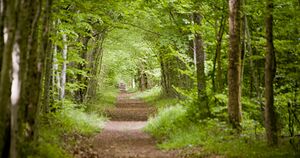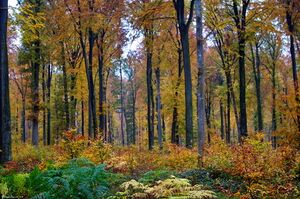Voisey
Republique of Voisey
Voisey is a sovereign state located on the continent of Europa.Voisey is a unitary constitutional republic with a semi-presidential regime. The motto has always been "Liberty, Fidelity, Justice". The national colours of the flag are blue, white and red with two black lions holding a coat of arms with a white lily, a sign of peace but of strength. Above the lily sits a giant fortress, a sign of resistance. Since 1733, the capital is Chaumont. The official language of Voisey is French. Dialects such as Pavois, Bassignot,Sennonais, Troyen, Argonnais,Rémois, Vallage, Langrois (which is a very rarely spoken dialect), Spinalien, Déodatien, Gaumais, Longovicien, Nancéien,Messin, Franc-comtois, and Francien are considered secondary languages and are spoken by about 71% of the population. The official currency is the Franc. Voisey has an important geopolitical role in the world, with an extensive network of embassies and consulates in all countries of the continent. Voisey is also the fifth largest nuclear power on the continent on a par with Artoisie. Voisey's has been repeatedly ranked in 1934, 1969, 1975, 1984-85, 2008, 2012 and 2020 as the world's number one Soft Power Rate thanks to its broad diplomatic reach, cultural richness and the strong international relations skills of its presidents. Voisey is the third largest economy in the world with a nominal GDP of 629.8 billion $US in 2021. With an unemployment rate of 2.2% (fourth quarter 2021), it has a "very high" standard of living (2nd in the HDI ranking in 2021). Voisey's is a world leader in the metal, food, automotive, nuclear and agricultural sectors. Voisey's is one of the largest countries in Europa. The culture of Voisey is very old and supported by its citizens, who are very conservative and proud of their traditions. The French language is used in the majority, although in some areas patois is used as the main language. Voisey is a member of several global and regional organisations such as WEMO (World Economic and Military Organisation) OMEM in French, IHO (International Health Organisation)OIS in French. Voisey is also part of the international free trade zone (white zone), the economic alliance of the Entente and the Paris Pact, aimed at helping nations in difficulty and, among other things, preventing a recurrence of the Great War (1969-1985).
Republic of Voisey République de Voisey | |
|---|---|
|
Flag | |
| Motto: "Liberté – Fidelité – Justice" (French) "Liberty – Fidelity – Justice" | |
| Capital | Chaumont |
| Largest city | Metz |
| Official languages | |
| Ethnic groups |
|
| Demonym(s) | Voiseyien, Voiseyienne |
| Government | Unitary Constitutional Republic |
| Daniel Marangé | |
| Raymond Barthélémy | |
| Legislature | National Assembly |
| Area | |
• Total | 53,633 km2 (20,708 sq mi) |
• Water (%) | 0.8% |
| Population | |
• 2021 estimate | 7 120 898 |
| GDP (nominal) | 2021 estimate |
• Total | $634 944 880 600 |
• Per capita | $89 166 |
| Gini | low |
| HDI (2021) | very high (2nd) |
| Currency | Franc (FV) |
| Time zone | UTC+0 |
| Driving side | right |
| Calling code | +33 |
| Internet TLD | .vy |
Geography
Location, borders and area
Voisey is located in the North-East of the Europa continent. The neighbouring countries are: Porhoët in the South-West, la Touloisie in the East, la Brenne in the South-East, le Bessin in the North-East and l'Artoisie in the North. Voisey has a coastline to the northwest characterised by granite cliffs very similar to those of Porhoët. Voisey is one of the largest countries in Europa with an area of 53,633 km2 . The borders with the neighbouring countries are characterised by small rivers, hedges or different types of fields. Stone milestones mark the separation every kilometre. However, there are customs at the main roads. During the Great War, the borders were guarded by the army.
Geology, topography and hydrography
Voisey is a relatively mountainous country. The highest peak is Haut de Baissey at 1424 m. The lowest point is the Jouvelle plain which is 310m above sea level. The Vosges massif to the east is also a high point in the area. These mountainous formations were formed during prehistoric times. The soils of Voisey are of sedimentary origin from the West and the ancient crystalline massif of the Vosges. Several rivers cross Voisey such as the Suize, which then flows into the sea, the Marne, the Meuse, the Meurthe, the Saône, the Aube, the Seine (which does not have its source in Voisey), the Aisne, which springs at Sommaisne and then flows into a larger river, the Oise.The Aisne ends its course at Amifontaine in Artoisie.
Climate
Voisey's climate is temperate with fairly marked regional or local variations. Voisey has experienced climatic events with significant consequences: storms (those of December 2002 paralysed the entire continent for months), floods, particularly the flooding of the Suize in 1942 and 2015, and severe droughts such as that of 2001, which put thousands of people at risk. A distinction is usually made between the strict oceanic climate, which is very marked in the west. The lowland degraded oceanic climate in the centre corresponds to frequent showers, fog and frost in winter. The semi-continental climate in the north-east and centre-east is itself subdivided and has characteristics that are further modified by the proximity of the mountain ranges. The eastern semi-continental climate is present from Burgundy to the Ardennes (from the south to the northwest). Finally, the mountain climate is present, mainly at altitude in the Vosges mountains. The average temperature in Voisey rose by an average of 0.1°C per decade during the 20th century. On 14 August 1905, a record was set in Conthil in the Moselle with 40.7 on the thermometer. On the contrary, another record was broken in January 1976 in Rocroi in the Ardennes with -34 C°.
Thanks to a policy of limiting the use of petroleum products and the importance of nuclear energy, Voisey's per capita CO2 emissions are lower than those of most of its neighbours. Greenhouse gas emissions in the Voisey's area represented about 2.4% of global emissions in 2017. Plastic production in Voisey fell by 10% between 2016 and 2017. The use of bicycles in cities has increased by 20% between 2010 and 2020. A 2013 survey by the Minister of Ecology found that "Voisey's carbon footprint is constantly decreasing".
Preservation of the environment
The public authorities have been trying to respond to these environmental challenges for several decades. Since 1967, nature reserves and national parks have been joined by regional nature parks, which combine conservation and development of the natural and cultural heritage. Two water agencies have been set up to manage and protect the country's water resources.
The Natura 52 network brings together natural or semi-natural sites in Europe with a high heritage value, due to the exceptional fauna and flora they contain. In December 2020, the Natura 52 network includes 342 sites in France, including 6 marine sites.
Spatial distribution of people and activities
Voisey is marked by multiple spatial imbalances. On the one hand, it has the originality of having a capital that is smaller than many other large cities in the country. It is home to a quarter of the country's students and a quarter of the country's major companies. The East, which has remained agricultural and is currently enjoying a major demographic and economic boom, and the West, with its developed industry and urbanisation. The table below lists the country's main cities in 2021, ranked by default according to their population. WIP:
| City | Intra-Muros |
|---|---|
| Chaumont | Example |
| Metz | Example |
| Nancy | Example |
| Dijon | Example |
| Troyes | Example |
| Bar-le-Duc | Example |
| Saint-Dizier | Example |
| Epinal | Example |
| Laon | Example |
| Charleville-Mezières | Example |
| Reims | Example |
| Auxerre | Example |
| Lunéville | Example |
| Soissons | Example |
| Bar-sur-Aube | Example |
| Beaune | Example |
| Vesoul | Example |
| Belfort | Example |
| Sarrebourg | Example |
| Chalons-en-Champagne | Example |




